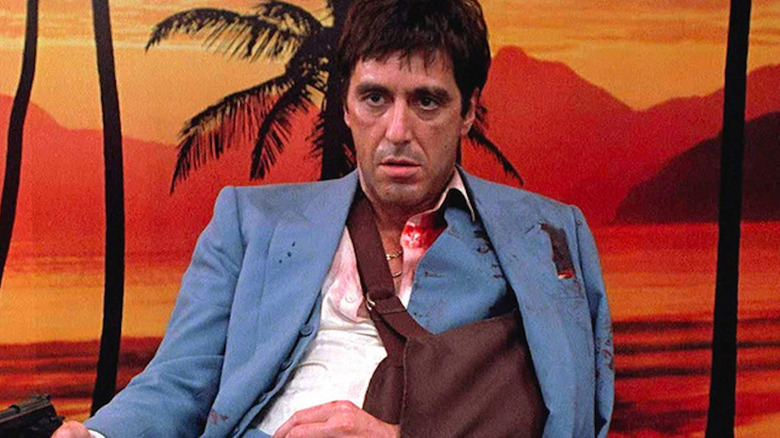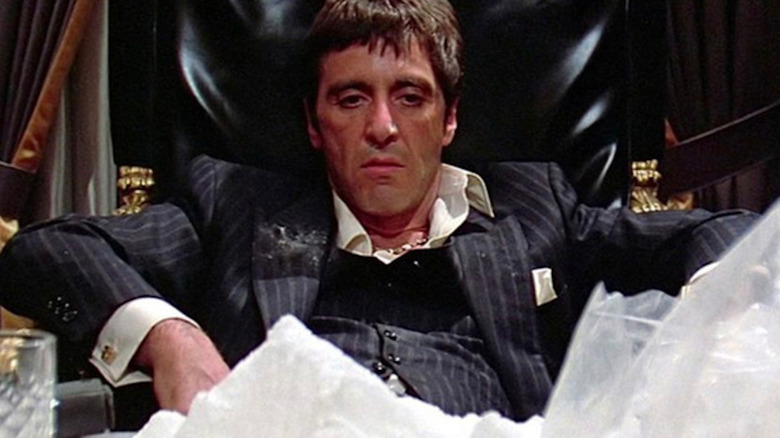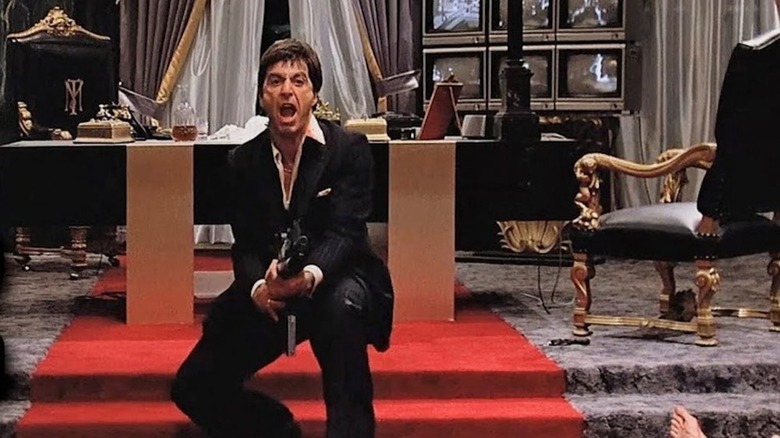The Rough Cut Of Scarface Was A Disaster In The Eyes Of Oliver Stone
Long before Brian De Palma's "Scarface" became a pop cultural obsession for the hip-hop community, it was considered a commercial misfire and an artistic failure for its director. The modernized riff on Howard Hawks 1932 gangster classic was an epic of wretched excess. It was crass, bloated, and unremittingly gruesome. De Palma's most fervent critical defender, The New Yorker's Pauline Kael, titled her review "A De Palma Movie for People Who Don't Like De Palma Movies," and she had a point. The sprawling 170-minute film lacked the formal/thematic cohesion of his best work. It was more of a showcase for Al Pacino, who delved so deep into the role of Cuban gang lord Tony Montana that he never fully shed the character's verbal tics (seriously, watch his movies and you'll see a very clear difference between pre- and post-"Scarface" Pacino).
39 years later, "Scarface" is still a lot of movie. It's too much. Montana's downfall is uncomfortably distended. His arc is flat: he's a monster from the start who seizes his opportunity and murders scores of people as he relentlessly pursues the American dream. Throw in the incestuous attachment to his kid sister Gina (Mary Elizabeth Mastrantonio), and Tony quickly becomes ghoulishly uninteresting. It's an ecstatically entertaining journey at times, but it grows repetitive in the scenes leading up to the climactic shootout.
In any event, "Scarface" was not the film people were expecting. It was supposed to be a major awards contender, an acting tour de force for Pacino and a segue to respectability for De Palma. When screenwriter Oliver Stone was invited to view a rough cut of "Scarface" prior to its December 1983 release, he realized he probably wouldn't be nominated for his second Best Adapted Screenplay Oscar.
A different kind of De Palma movie
In his memoir "Chasing the Light," Stone remembers being asked by producer Martin Bregman to watch the film in a "small, crummy New York screening room." Bregman, anticipating a negative reaction from Stone, was worried he might share his disappointment with Pacino, so he warned the writer to share his opinion with him first. Indeed, Stone was unhappy with the cut, which, at 169 minutes (one minute off from the release version), was far more finished than your typical four-hour rough cut.
On one hand, this was unsurprising. De Palma generally does not shoot coverage – i.e. footage shot from a variety of angles to give the director options in post-production. I once watched the last 20 minutes of "Blow Out" with editor Paul Hirsch at the back of the New Beverly Cinema, and he said the scenes were pretty much shot as they were drawn up. De Palma knew exactly what he wanted.
"Scarface" was a new challenge for De Palma in that it was a massive studio gig that did not originate with him (Sidney Lumet was the first director hired), so he worked a little looser than usual. For example, he let his pal Steven Spielberg, who was visiting the set, direct a second-unit shot of gunmen deploying grappling hooks to invade Montana's mansion during the film's conclusion. Still, De Palma, who possesses a preternatural sense of camera placement and mise en scene, could only depart from his traditional style of filmmaking so much. He almost certainly had the majority of this movie cut in his head prior to the edit. So what Stone objected to — and, boy, did he object — was De Palma's envisioning of "Scarface."
Stone's time would come
"I grew massively depressed," said Stone. "All our work seemed to have gone up in flames." In Stone's view, the flaws were evident, and they had to do with the middle section of the movie:
"The beginning and the end were going to be okay, but the middle needed a tremendous amount of attention. I understood that; as a screenwriter, you can't attach yourself emotionally to the outcome of a film, but how else could I have written it? The overall sluggish pace, the lack of cohesion and meaning overwhelmed me."
Stone offers no concrete solutions to the film in his memoir. He says he gave notes, and some were addressed, but he was generally shoved aside as he had been by director Alan Parker on "Midnight Express." Three years later, he would step up with two superb directorial efforts in "Salvador" and "Platoon." He wrote those movies, and tended to stick to his own material from that point forward (though he caught a scorching bit of hell with his adaptation of Quentin Tarantino's "Natural Born Killers").
"Scarface" belongs to Brian De Palma and Al Pacino. Love it or hate it (and it's entirely justifiable to veer between both extremes), but it's the work of two artists redlining their talent to make a wildly reprehensible film. It's as exhilarating as it is ugly, and I'm so very happy it exists.


